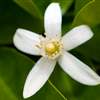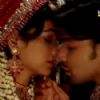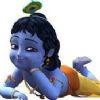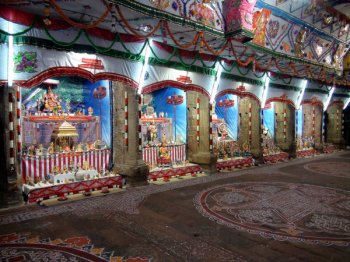In the Puranas and Agamas, endless aspects of Devi Durga are mentioned. She symbolises Creation, Preservation and Destruction of the three worlds and is usually depicted as having 8 arms which symbolise the extent of her protective powers from different directions, she is the personification of all male energy obtained from the Tridevas as well as the female force or Shakti that is the creative, dynamic and active energy of all existence. She has infinite power to protect from destructive forces.
Known as Mahishasurmardini, she is the combined creative energies of Consciousness. She is responsible for the entire Srushti or Cosmic creation.
It is believed, Goddess MahaKali, MahaLakshmi, MahaSaraswati, came together and fought the evil asuras who were planning to take up the whole universe. This battle went on for nine days and on the nineth day the good was finally able to defeat the bad force. The asuras were killed. Lord Shiva had given the Asuras, boon that only women could kill them and no man will be able to touch them. The Devas were not able to kill these Asuras because of this boon. Then the Devas went and requested lord Vishnu. Durga incarnated as the united power of all divine beings, who offered her the required physical attributes and weapons to kill the demon "Mahishasur". she faught with the Asura & killed him after a battle that lasted nine long days. Since those days these nine days are celebrated to worship this strength. The goddess is requested to come to earth and remove all the evil from here.
The word "Durga" in Sanskrit means a fort, or a place which is difficult to over run. She is "Durgatinashini," the one who eliminates sufferings. She protects her devotees from the evils of the world and at the same time removes their miseries.
There are many forms of Durga: Kali, Bhagvati, Bhavani, Ambika, Lalita, Gauri, Kandalini, Java, Rajeswari, etc. Her nine forms are Shailputri, Brhmacharini, Chandraghant, Kusumanda, Skandamata, Katyayani, Kaalratri, Maha Gauri and Siddhidatri.
Durga's Many Arms
Durga is depicted as having eight or ten hands. These represent eight quadrants or ten directions suggesting, she protects the devotees from all directions.
Durga's Three Eyes
Like Shiva, Mother Durga is also referred to as "Triyambake" meaning the three eyed Goddess. The left eye represents desire (the moon), the right eye represents action (the sun), and the central eye knowledge (fire).
Durga's Vehicle - the Lion
The lion represents power, will and determination. Mother Durga riding the lion symbolises her mastery over all these qualities. This suggests to the devotee that one has to possess all these qualities to get over the demon of ego.
Durga's Many Weapons
The conch shell in Durga's hand symbolizes the 'Pranava' or the mystic word 'Om', which indicates her holding on to God in the form of sound.
Four Devi Navratra Festivals:
Sharad Navratri is one of the major festival celebrated in month of Ashwin. All four Navratras, Ashwin Navratri, Vasant Navratra, Ashad Navratri and Magh Navratra are dedicated to the Mother Goddess Shakti. During every Navratri festival, one thing is similar that Goddess Durga (Navdurga) is worshipped for nine days in her nine forms or manifestations, each day a new avatar.During Navaratri every year, we meditate upon Devi Durga & invoke her power to destroy all evil tendencies in the mind, that may have the qualities of Tamas or inertia, ignorance & darkness so to lead us towards enlightenment. Three important aspects of life ' the power of courage, wealth and knowledge ' are asked from the Mother Goddess.
People in western India, especially in Gujarat, spend the nine nights of Navratri in song, dance and merriment. Garba is a graceful form of dance, wherein women dressed in exquisitely embroidered choli, ghagra and bandhani dupattas, dance gracefully in circles around a pot containing a lamp, called "Garba" or "Garbha" means "womb", and in this context the lamp in the pot, symbolically represent life within a womb.
The word Garbo or Garaba has originated from Sanskrit word "Garbhdeep"- an earthen pot with circular holes is popularly known as Garbo. The earthen pot is symbol of human body and the lighten lamp inside signifies the divine soul.
Besides the Garba is the "Dandia" dance, in which men and women participate in pairs with small, decorated bamboo sticks called dandias in their hands. At the end of these dandias are tied tiny bells called ghungroos that make a jingling sound when the sticks hit one another. The dance has a complex rhythm. The dancers begin with a slow tempo, and go into frenzied movements, in such a manner that each person in a circle not only performs a solo dance with his own sticks, but also strikes his partners dandies in
Durga Puja: In Eastern India mainly in Bihar, Jharkhand, West Bengal, Orissa, Assam, last 4 days of are celebrated as Durga Puja. It is the biggest festival of the year here. Gigantic clay idols of Goddess Durga depicting slaying of buffalo demon Mahishasura are brought home for four days and worshipped. After four days of festivities, when Durga's entry into homes is celebrated as a daughter's return to her maiden home, Durga is given a fitting farewell with the call to come again the following year.Durga Puja which mainly starts on Durga Saptami. Shandhi Puja, Shidhor Khela, Kanya Pooja and Mahanavami puja are the main rituals during Navratri.
Vijayadashmi or Dashera
Dashera, as the name suggests occurs on the "tenth" day following the Navratri. It is a festival to celebrate the triumph of good over evil, and marks the defeat and death of the demon king Ravana by Lord Ram in the epic Ramayana. Huge effigies of Ravana are burnt amongst the burning of fire crackers.
It is believed that Lord Ram had to pray to the nine different aspects of Devi to be able to kill Ravana. He then accumulated enough power to kill Ravana on the tenth day, which was called Vijayadashmi or Dashera. Since then, the tradition of praying to Devi for nine days has continued. The nine days therefore are celebrated in honour of victory of good over evil.
Vijaya Dashami is also called as Aparajita Dashami and on this day Aparajita puja and Shami Puja are performed.






















comment:
p_commentcount